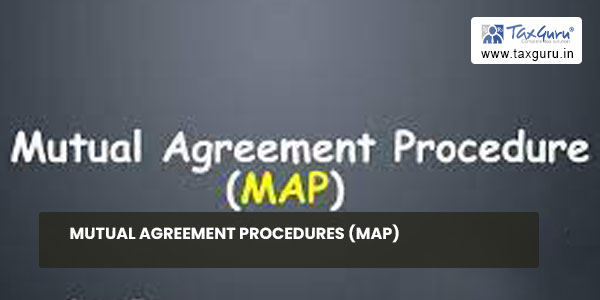Article explains What is Mutual Agreement Procedures (MAP), Why do countries need MAP, Who can initiate MAP and how, Who can’t access MAP, What are the differences between MAP provisions under OECD and UN Model Conventions, Recent Statistics of MAP Cases and What does Action Plan of BEPS say about MAP?
Introduction
In digital tax era, there are various situation that give rise to disputes while entering into cross border transactions. OECD has come with a dispute resolution mechanism to solve taxpayers confusion regarding double taxation and non-taxation according to DTAAs , known as Mutual Agreement Procedures (MAP).
MAP provides either full or partial relief from double taxation. All the DTAAs entered by India have MAP article to provide independent legal remedies to international law interpretation disputes whether available under domestic law or through competent authorities of the contracting states.
Why MAP?
Interpreting the ambiguous terms and provisions of bilateral and multilateral negotiations give arise to disputes during cross border transactions.
Other than interpretation disputes , there are cases involving jurisdical double taxation (Same Income taxed twice in the hands of same entity in two different contracting states) and economic double taxation( Same Income taxed twice but in the hands of two different entities in two different contracting states).
Disputes may arise in the following circumstances entailing double taxation or non-taxation as per DTAAs:
- Transfer Pricing Adjustments.
- Advance Pricing Agreements Negotiations.
- Determining presence of Permanent Establishment.
- Imputation of profits to a Permanent Establishment
- Depiction of Income and expenses.
Therefore, MAP is a key instrument providing procedures to solve such disputes and curbing problems of double taxation.
MAP Initiation
MAP is initiated at the request of the taxpayer whenever the dispute arises between:
- Competent authority of a contracting state and a taxpayer resident of other contracting state.
- Time Limit for initiating MAP is Three years in case of UN Model while Two years in case of OECD Model
In OECD model an aggrieved taxpayer can contact competent authorities of either of the competent authorities whether he is a resident of that state or not. While in UN model an aggrieved taxpayer can contact the competent authorities of that State of which he is a resident.

For India’s Dispute Resolution, MAP request should be made to respective officers as follows:
- An officer assigned for countries situated in North America (including Caribbean Islands) and Europe.
- An officer assigned for other countries except situated in North America (including Caribbean Islands) and Europe.
MAP Access Denial
MAP can’t be accessed in following situations:
- Taxpayers who requested MAP found guilty of fraud or requested to initiate MAP with the objective of tax avoidance.
- Contravention of Domestic Laws of a contracting state
- Serious liability cases where possibility of stay arises.
Comparison between OECD and UN Model Convention
|
OECD Model Convention on MAP. |
UN Model Convention on MAP |
| Article 25 of the OECD Model Convention states about these dispute resolution mechanism aiming at resolving disputes between the competent authorities. MAP initiated at the request of taxpayer aggrieved by double taxation.
According to Para 1 and 2 of the Article 25, aggrieved taxpayer with double taxation shall present the case before competent authorities within two years from first notification of the action resulting in taxation not in accordance with the DTAA norms and competent authorities shall endeavour if the justified objection is there, otherwise the competent authorities shall solve the disputes directly coordinating with each other. |
Article 25 of the UN Convention provides two alternatives for solving disputes within three years’ time from the submission of the case. If competent authorities are not able to get on any conclusion, they shall proceed to initiate the arbitration proceedings.
Alternative B allows the competent authorities to depart from arbitration if they agree on different solution after six months of arbitration decision being communicated to them. |
Recent Statistics
Recent Statistics of MAP below showing cases initiated and solved within the average time.
https://www.oecd.org/ctp/dispute/mutual-agreement-procedure-statistics.htm
Country- wise statistics
https://www.oecd.org/tax/dispute/mutual-agreement-procedure-statistics-2020-per-jurisdiction-all.htm
India’s Statistics
https://www.oecd.org/tax/dispute/2020-map-statistics-india.pdf
MAP Provision in BEPS Action Plan 14
BEPS Action Plan 14 guides for making dispute resolution mechanism more effective. BEPS Action Plan provides a minimum standard to ensure timely resolution of international tax disputes in effective and efficient manner.
The OECD strongly supports the view of having MAP provision in every country’s DTAA as various challenges regarding international transaction hits the country’s assessees’ due to double taxation of their income. Usually these challenges arises due to treaty abuse or misinterpretation of the treaty.
The Action Plan consists of twenty one elements and twelve best practices helps in curbing the jurisdiction’s legal and administrative framework in the following four key areas:
1. Preventing Disputes
2. Availability and access to MAP
3. Resolution of MAP cases
4. Implementation of MAP Agreements
Other measures agreed upon by the OECD members are:
- Peer review process for measuring the implementation of this standard and
- MAP statistics report under MAP Framework.
Conclusion
As a result of introduction of Mutual Agreement Procedures, countries and territories are able to get the number of international transaction disputes resolved within the minimum time limit and involvement of competent authorities of the countries or territories involved in the disputed transaction leads to conclusive results.
Though BEPS Action Plan does not lay down any standard procedure to curb these interpretational issues arising in these international transactions, but do provide us with the implementation process and time to time MAP statistics reporting points out the common issues, therefore avoiding them from arising in future.
A dispute resolution mechanism should be easy to understand and politically attainable and able to curb the problems of treaty abuse due to interpretational issues.
In the nutshell, Mutual Agreement Procedures being the dispute resolution mechanism needs a little improvement for providing better support to the country’s political stability and instant relief to aggrieved assessees’.
Disclaimer: The contents of this article are solely for informational purpose. Neither this article nor the informations as contained herein constitutes a contract or will form the basis of a contract. The material contained in this article does not constitute or substitute professional advice that may be required before acting on any matter. While every care has been taken in the preparation of this article to ensure its accuracy at the time of publication. Jyotsana Thareja assumes no responsibility for any error which despite all precautions may be found herein. We shall not be liable for direct, indirect or consequential damages if any arising out of or in any way connected with the use of this article or the informations as contained herein.






Very nice and informative Article!!
Very informative article!